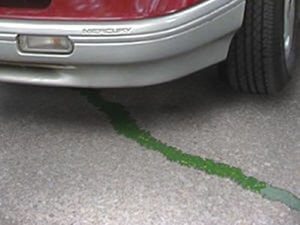How Much Does Coolant Leak Repair Cost?
Last Updated on December 14, 2023
Written by CPA Alec Pow | Content Reviewed by ![]() CFA Alexander Popinker
CFA Alexander Popinker
Finding bright green or pink puddles under vehicles requires a quick response before small leaks in the cooling system become big problems. But the source of leaks hides well, challenging even experienced mechanics to find. Understanding how cooling systems function helps in better grasping repairs when automotive repair shops check for damages.
How Much Does Coolant Leak Repair Cost?
The coolant leak repair cost can vary significantly based on several factors:
- Extent of Damage: The more severe the leak, the higher the repair cost.
- Geographical Location: Labor costs can vary based on your location.
- Service Provider: Costs can differ between chain auto centers and local mechanics.
The cost of coolant leak repair is anywhere between $100 and $835 at chain auto centers, while local mechanics will charge between $165 and $910.
Factors Influencing Repair Costs
Key factors influencing the cost of repairing a coolant leak include:
- Labor Time: More complex repairs, such as reaching hidden pumps or lines, require more work hours, thus increasing costs. Vehicles like all-wheel drive models may incur additional labor.
- Broken Parts: Simple tasks like resealing cracked hoses are less expensive compared to replacing major components like radiators or heater cores.
Repair estimates can vary widely, with minor fixes like external hose patching starting at around $200 and more comprehensive replacements exceeding $1,000. Free diagnostic checks can help in determining the current pricing.
What Coolant Does
Coolant liquid, also known as antifreeze, flows through special pipes to pull damaging heat away from the engine and radiator. This very important fluid balances temperatures for optimal performance and prevents overheating failures over thousands of ignitions. Coolant not only maintains temperature but also keeps the system lubricated and rust-free, combating extreme friction from high-speed operations.
Coolant Details
The “coolant,” typically a glycol-based liquid, plays a very important role in engine cooling. It circulates through the engine and radiator in a closed circuit, transferring heat from the engine to the environment.
 The cooling system comprises the engine cooling radiator, radiator hoses, fan, thermostat, water pump, and expansion vessel. The coolant is often diluted in distilled water and contains additives that prevent freezing, overheating, and corrosion.
The cooling system comprises the engine cooling radiator, radiator hoses, fan, thermostat, water pump, and expansion vessel. The coolant is often diluted in distilled water and contains additives that prevent freezing, overheating, and corrosion.
You might also like our articles about the cost of transmission front seal leak, oil leak, or exhaust leak repair.
Coolant Leak Repair Overview
Addressing a coolant leak typically involves a mechanic inspecting the car to assess the severity of the issue, followed by draining the coolant and repairing or replacing any broken parts. After repairs, a drive test is conducted to ensure the cooling system is functioning correctly. Timing for these repairs can range from a couple of hours for minor issues to several days for more extensive damage.
Important Things to Consider
- Immediate Action: Stop driving if a coolant leak is suspected.
- Preventative Measures: Modify driving habits to reduce leak occurrences.
- Regular Checks: Regularly inspect the coolant level and the cooling system for potential leaks or damage.
- Coolant Compatibility: Ensure the coolant is suitable for your engine to avoid damage.
Standard Repair Process
The repair process typically involves pressure testing, draining the fluid, replacing failed parts, refilling with the appropriate coolant, bleeding air pockets, rechecking for leaks, and a final test drive. Certified technicians ensure each step is meticulously executed for a reliable fix.
DIY Repairs vs Professional Shops
While DIY enthusiasts might attempt minor repairs, complex or worsening leaks should be addressed by professional mechanics to avoid further damage.
Signs of an Antifreeze Leak
- Puddles: Neon green or bright pink puddles under the car are telltale signs of a leak.
- Odors: A sweet, fruity smell can indicate coolant escaping from the system.
- Overheating: An unusually hot engine gauge can signal a coolant issue.
Finding Hidden Leak Spots
Leaks often occur around water pumps, radiator seals, overflow tanks, and hose connections. Regular system checks can help identify these problems early.
Preventative Coolant Maintenance
Maintaining the coolant system involves regular flushing, using proper filling techniques, avoiding tap water, and ensuring compatibility when switching brands.
Conclusion
Proactive maintenance and understanding the nuances of coolant systems are key to preventing costly repairs. Recognizing early signs of trouble, coupled with timely professional assistance, keeps the system running smoothly.
Staying informed about the potential costs associated with coolant leak repairs empowers vehicle owners to make informed decisions about their car’s maintenance.


Leave a Reply
Want to join the discussion?Feel free to contribute!